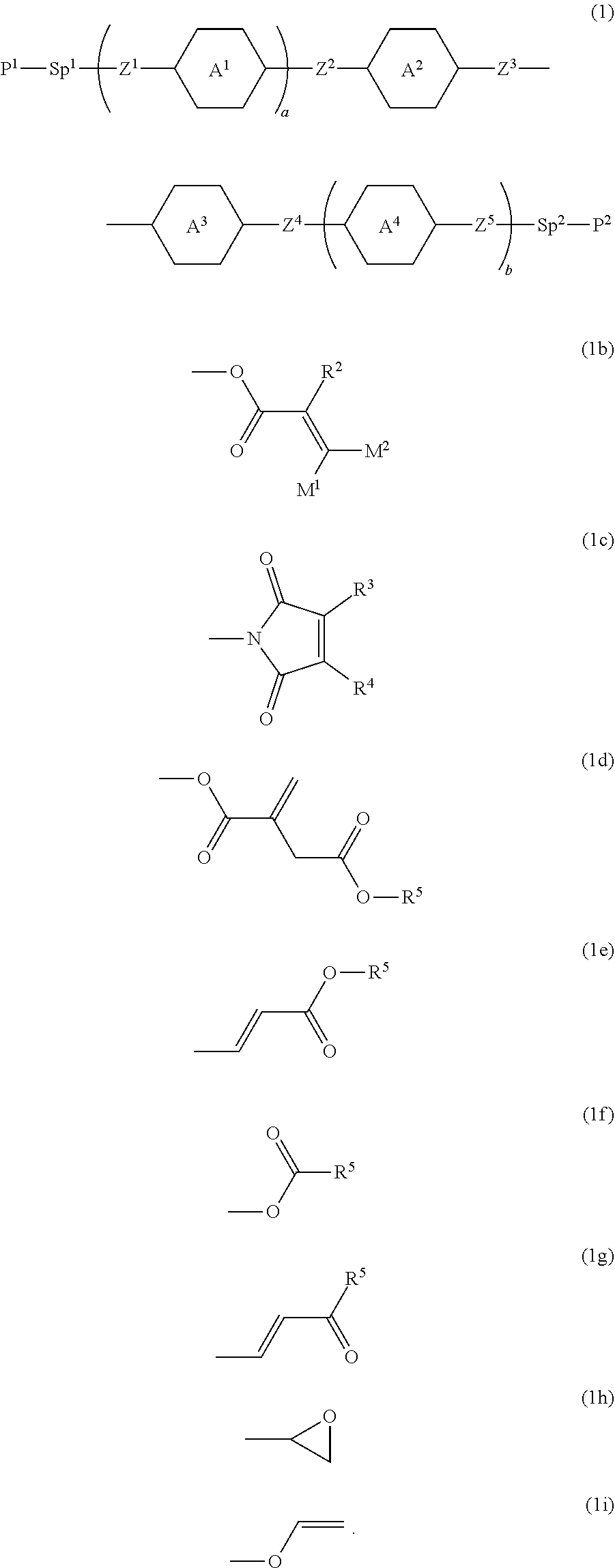Polymerizable polar compound, liquid crystal composition and liquid crystal display device
a technology of liquid crystal composition and polymer, which is applied in the direction of instruments, organic chemistry, chemistry apparatus and processes, etc., can solve the problems of difficult maintenance of compatibility between low molecular weight compound or polymer and liquid crystal composition, small electric power consumption and large contrast ratio in the device, and achieve high solubility in the liquid crystal composition, the ability to horizontally align liquid crystal molecules, and the effect of high chemical stability
- Summary
- Abstract
- Description
- Claims
- Application Information
AI Technical Summary
Benefits of technology
Problems solved by technology
Method used
Image
Examples
synthesis example 1
Synthesis of Compound (No. 59)
[0251]
First Step
[0252]Compound (T-1) (20 g), cyclohexanol (200 mL) and p-toluene sulfonic acid monohydrate (PTSA-H2O) (0.4 g) were put in a reaction vessel, and the resulting mixture was stirred at 60° C. for 48 hours. The resulting solution was concentrated under reduced pressure, and the residue was purified by silica gel chromatography (toluene: ethyl acetate=2:1 in a volume ratio) to obtain compound (T-2) (32 g; 98%).
Second Step
[0253]In a reaction vessel, 4,4′-biphenyldiol (10 g), 4-hydroxybenzoic acid (7.4 g), 4-dimethylaminopyridine (DMAP) (0.34 g), and dichloromethane (200 mL) were put, and the resulting mixture was cooled down to 0° C. Thereto, DCC (11 g) was added, and the resulting mixture was stirred for 12 hours while returning to room temperature. After an insoluble matter was filtered off, the reaction mixture was poured into water, and an aqueous layer was subjected to extraction with ethyl acetate. An organic layer was washed with water,...
synthesis example 2
Synthesis of Compound (No. 401)
[0259]
First Step
[0260]In a reaction vessel, 4-hydroxybenzaldehyde (10 g), 4-hydroxyacetophenone (11 g), sodium hydroxide (6.5 g), and methanol (200 mL) were put, and the resulting mixture was stirred at 40° C. for 12 hours. The reaction mixture was poured into water, neutralized with hydrochloric acid, and then subjected to extraction with ethyl acetate. An organic layer was washed with water, and dried over anhydrous magnesium sulfate. The solution was concentrated under reduced pressure, and the resulting residue was recrystallized in ethyl acetate to obtain compound (T-4) (5 g; 25%).
Second Step
[0261]Compound (T-4) (5 g), compound (T-5) (6 g), DMAP (0.25 g) and dichloromethane (200 mL) were put in a reaction vessel, and the resulting mixture was cooled down to 0° C. Thereto, DCC (8.6 g) was added, and the resulting mixture was stirred for 12 hours while returning to room temperature. After an insoluble matter was filtered off, the reaction mixture wa...
use example 1
[0349]To composition (M1), compound (No. 59) was added at a proportion of 0.1% by weight as a first additive, and compound (AO-1) in which R40 is n-heptyl was added at a proportion of 150 ppm as an antioxidant. The resulting mixture was injected into an IPS device having no alignment film at 90° C. (equal to or higher than a maximum temperature of a nematic phase). The IPS device was irradiated with linearly polarized ultraviolet light (313 nm, 2.0 J / cm2) from a direction normal to the device while heating the device at 90° C. to obtain a device subjected to alignment treatment. The resulting device was set on a polarizing microscope in which a polarizer and an analyzer were arranged perpendicularly to each other to be parallel to a polarization axis of linearly polarized light in the device. The device was irradiated with light from below, and presence or absence of light leakage was observed. A case where no light passed through the device was judged to be “Good” in alignment. A c...
PUM
| Property | Measurement | Unit |
|---|---|---|
| temperature | aaaaa | aaaaa |
| temperature | aaaaa | aaaaa |
| response time | aaaaa | aaaaa |
Abstract
Description
Claims
Application Information
 Login to View More
Login to View More - R&D
- Intellectual Property
- Life Sciences
- Materials
- Tech Scout
- Unparalleled Data Quality
- Higher Quality Content
- 60% Fewer Hallucinations
Browse by: Latest US Patents, China's latest patents, Technical Efficacy Thesaurus, Application Domain, Technology Topic, Popular Technical Reports.
© 2025 PatSnap. All rights reserved.Legal|Privacy policy|Modern Slavery Act Transparency Statement|Sitemap|About US| Contact US: help@patsnap.com



